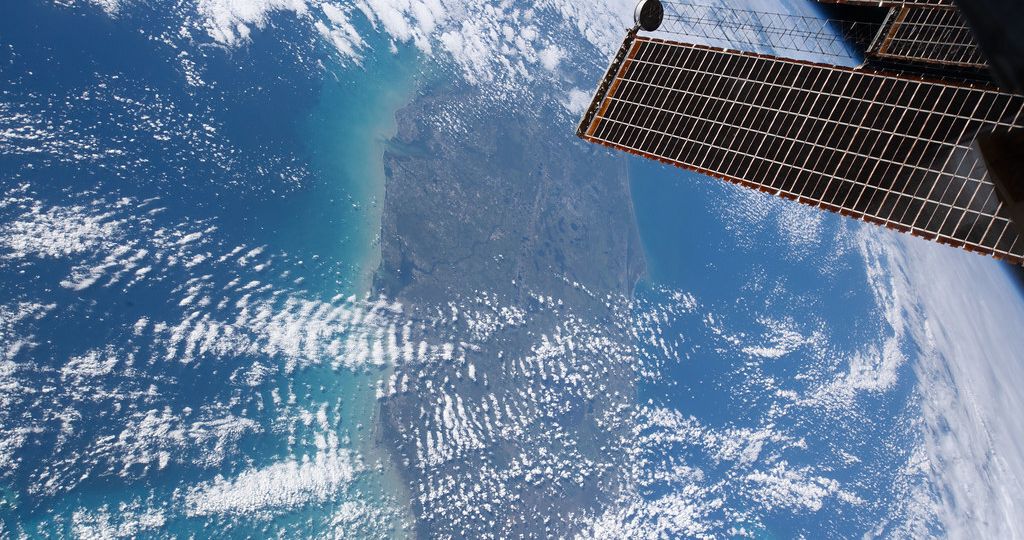
Gulf of Mexico ‘Eye of Fire’ Symbolizes a Climate Collapse
A fire on the surface of the ocean west of Mexico’s Yucatan Peninsula sparked a widespread conversation about the extent of the severe climate change crisis we are experiencing and what comes next.
Amid record-breaking heat waves and multiplying wildfires in the western United States, flames emerged the morning of Friday, July 2 in an unlikely location– on the surface of the Gulf of Mexico. A monstrous fire raged on for several hours, after a gas leak transpired from a burst underwater pipeline connected to a platform designed for offshore drilling, operated by Pemex, Mexico’s state-owned oil company.
The images that came out of this event were daunting, and many expressed their concerns about what this means for the larger picture of the climate change crisis. Over 75 major companies such as Google, Apple and Lyft signed a letter on Wednesday, July 7, pushing Congress to take on a federal clean electricity standard. The letter outlines a goal that would achieve 80% carbon neutrality by the end of the decade.
Death Valley, Californa broke the record for the hottest temperature recorded on Earth for the second year in a row, a scorching 130.0 degrees Fahrenheit on Friday, July 9. While western Colorado faces a troubling drought, Hurricane Elsa caused flooding in the subways of New York City. Unprecedented climate disasters seem to be frequent—happening almost daily—and the Biden administration was expected to make strides in climate policy, however a remarkable climate bill has not passed yet.
“It will take decades of sustained support for clean energy technologies to mitigate the worst climate change-related issues, and even that will not fix them,” said Dr. Brim-Mathias Hodge, associate professor in the department of electrical, computer and energy engineering, and a fellow of the renewable and sustainable energy institute at the University of Colorado Boulder. “We are already too far down the road for that. We need a combination of local, state and federal laws, as well as real changes in consumer behavior to mitigate the worst impacts.”
On June 24, Biden announced a bipartisan infrastructure bill, and many expected large climate investments to be included. However, the bill only addresses a small portion about carbon pollution, which would hardly help slow the progression of climate change. Hodge expressed his concern for how long the transition for renewable energies will take to implement on a larger scale.
“We take for granted that we will have reliable electricity, water and natural gas whenever we want it, but there are enormous infrastructure systems that took decades to build to make that possible,” Hodge said. “I do think that these changes will happen; it’s how long it will take that is the real question.”
A common remark about clean resources and abolishing fossil fuels is that it’s not a realistic goal. However, scientists have agreed, as well as CU Boulder’s top researchers, that it is not impossible to accomplish.
“Wind is cheaper than coal, and even gas, even without subsidies,” said Dr. Kyri Baker, assistant professor in the CU Boulder civil, environmental, and architectural engineering department and fellow in the renewable and sustainable energy institute. “As evidenced by a lot of recent climate disasters and heatwaves, which are at least partially likely due to climate change, continuing to use fossil fuels can be extremely expensive.”
Although these renewable resources have been available for some time, the process behind making the substitute has proven to be a demanding one. Dr. Lisa Barlow, a senior instructor of geology and sustainability at CU Boulder discussed how not all alternatives to fossil fuels are equal and easy to come by, including hydropower.
Tidal currents and ocean currents have potential, and we humans need to be smarter than we have in the past, we need to consider the consequences of taking energy from currents for the ecosystems that we would be disturbing.– Dr. Lisa Barlow
In the time of a climate war, younger generations are pushing to implement renewable energies. However, it is much more than having renewable resource solutions, to efficiently extract them, it takes significant land use, which is a complex process to do quickly.
“Ground heat geothermal has better potential,” Barlow said. “Using the near-surface-Earth’s constant temperature as a pre-heating and pre-cooling mechanism is a proven and marketed technology that will help to lower the amount of greenhouse gases used to heat and cool buildings. However, one has to have [own] access to land next to the building to install a ground heat geothermal system.”
Baker explains it’s more crucial now more than ever to pursue all possible solutions.
“On the individual and community level, we need to educate ourselves, start learning more about how we can make a positive impact on the environment, and probably start being a bit more flexible with how and when we use energy,” Baker said.
Learn more …
For a scientific understanding of climate change in the United States –
- The Fourth National Climate Assessment, Volume II: Impacts, Risks, and Adaptation in the United States, addressed the science of climate change in the United States. Reporting conducted by the U.S. Global Change Research Program. https://nca2018.globalchange.gov/
For more information on how to live more sustainably-
- “Minimalism”- Sustainable documentary directed by Matt D’Avella in 2016, that explores minimalism as an ideology and how your life can be better when you strive to use less. https://minimalismfilm.com.
To learn more about all types of renewable energies-
- Visit the National Renewable Energy Laboratory site to gain knowledge about our options for renewable energies and how they operate. https://www.nrel.gov/research/learning.html
Check out these climate change motivated podcasts-
- Hot Take by Amy Westervelt and Mary Heglar
- Climate Cast from MPR News by Paul Huttner
- Inherited by Georgia Wright and Julianna Bradley
- Costing the Earth from BBC

